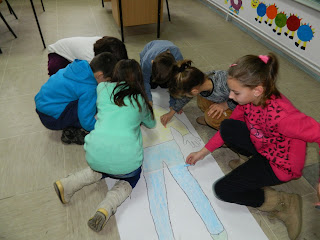I like to engage my students as much as possible both in the learning process and in the creation of the learning/ teaching materials.
On this lesson we did some revision and created a poster with parts of the body that can be used on other lessons in the future that deal with the same set of words.
1. Warm up: To start the lesson I decided to do a quick TPR activity - listen and do. The teacher names the part of the body and the students point to it. Or the teacher can include some verbs together with the body parts and ask the students to move.
2. Main part: I prepared one poster big enough for a student to lie on. I gave the instructions to the students how to draw a boy on the poster. Then we colored it and decorated it.
2.1 I gave the students some pieces of paper with parts of the body vocabulary written on them. There was one letter missing in each word. The students had to guess the word on the piece of paper, complete the spelling, then put the word on the correct place on the poster and spell the word.
On this lesson we did some revision and created a poster with parts of the body that can be used on other lessons in the future that deal with the same set of words.
1. Warm up: To start the lesson I decided to do a quick TPR activity - listen and do. The teacher names the part of the body and the students point to it. Or the teacher can include some verbs together with the body parts and ask the students to move.
2. Main part: I prepared one poster big enough for a student to lie on. I gave the instructions to the students how to draw a boy on the poster. Then we colored it and decorated it.
2.1 I gave the students some pieces of paper with parts of the body vocabulary written on them. There was one letter missing in each word. The students had to guess the word on the piece of paper, complete the spelling, then put the word on the correct place on the poster and spell the word.
3. End of class activity - It's always good to finish the lesson on a positive note. Young learners love music and dancing. I played some music in the background but I asked the students to dance according to what I said. They had to follow the rhythm of the music but dance "head to head" or "arm to arm" with their partner.


















































